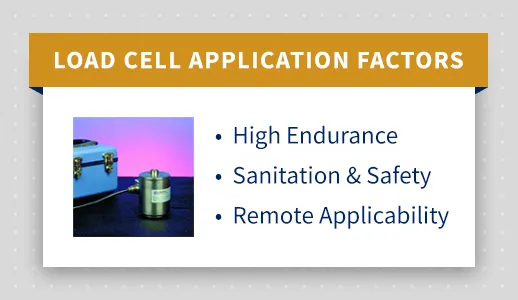Menu
How to Select the Right Load Cell
 The process of choosing a load cell is often complicated by the fact that each option has its own unique benefits. Truth be told, different load cell applications have their own special requirements. As such, you should discuss load cell capacity requirements with a knowledgeable supplier in advance of making a selection.
The decision you arrive at based on the load cell selection criteria is only one step in the overall process of implementation. Beyond that, you must still ensure you correctly installed and equipped the load cell with the proper instrumentation, otherwise you will not get precise measurements. This load cell selection guide will help you make a more informed choice.
The process of choosing a load cell is often complicated by the fact that each option has its own unique benefits. Truth be told, different load cell applications have their own special requirements. As such, you should discuss load cell capacity requirements with a knowledgeable supplier in advance of making a selection.
The decision you arrive at based on the load cell selection criteria is only one step in the overall process of implementation. Beyond that, you must still ensure you correctly installed and equipped the load cell with the proper instrumentation, otherwise you will not get precise measurements. This load cell selection guide will help you make a more informed choice.
Understand Your Application
In order to understand your load cell application, you must determine how to conduct the measurement and how the load should be applied. The process of measurement concerns a variety of factors, including:- Bending
- Compression
- Multi-axis
- Tension
Define Your Capacity Requirements
 Determine the maximum amount of load capacity required for your applications, as well as the necessary minimum.
As you go about determining the load cell capacity requirements of your application, you will need to bear in mind the extraneous factors. To ensure you have the optimal capacity, choose one that exceeds the highest operating load. Moreover, you will need to establish which engineering units will be required for the process. The combined stress caused by extraneous load and moments can put a dampener on the performance of an application.
Consequently, you could seriously compromise the accuracy of an application if you fail to select the proper load cell.
The majority of in-line sensors are ill-equipped for the possibility of extraneous load. For the more high-endurance applications, choose a sensor with an optimal fatigue rating, as specified by the manufacturer.
Determine the maximum amount of load capacity required for your applications, as well as the necessary minimum.
As you go about determining the load cell capacity requirements of your application, you will need to bear in mind the extraneous factors. To ensure you have the optimal capacity, choose one that exceeds the highest operating load. Moreover, you will need to establish which engineering units will be required for the process. The combined stress caused by extraneous load and moments can put a dampener on the performance of an application.
Consequently, you could seriously compromise the accuracy of an application if you fail to select the proper load cell.
The majority of in-line sensors are ill-equipped for the possibility of extraneous load. For the more high-endurance applications, choose a sensor with an optimal fatigue rating, as specified by the manufacturer.
Define Your Load Cell Needs
In order to select the right load cell, determine the needs of your applications. The following questions can help you make that determination:- Is the load of your application dynamic or static?
- Do you intend to make in-line use of the load cell?
- Do you intend to make side-mounted use of the load cell?
- Compressor washer
- Female/male thread
- Flange mount
- In-line
- Side mount
- Thru-hole
Define Your Size and Specification Requirements
Another key component of load cell selection criteria is the definition of size requirements. Most specifically, you must determine the needs of your application along the following measures:- Width and height
- Weight
- Length
- Bridge resistance
- Hysteresis
- Nonlinearity
Select Instrumentation
At the same time you choose a load cell, be prepared to also select any necessary instruments for the applications you intend to perform. When you pick all the vital pieces at the same time, you can better ensure a system-wide functionality between every component in use. You should also include system calibration in your order. This will ensure you integrate your instrument and sensor for the same system. Calibration is a vital component to all load cell applications.Load Cell Applications
 A variety of load cell options are preferable in relation to the demands of the setting or application in question. As you learn how to select the right load cell for a particular application, consider your foremost requirements. In general, the performance of a load cell will correlate to the demands of an application as follows:
A variety of load cell options are preferable in relation to the demands of the setting or application in question. As you learn how to select the right load cell for a particular application, consider your foremost requirements. In general, the performance of a load cell will correlate to the demands of an application as follows:
- High endurance. In an industrial setting, a strain gage load cell is one of the best options, because the accuracy is near perfect in applications that involve experimental stress.
- Sanitation and safety. In applications that demand precise mechanical balance, pneumatic load cells are the more preferable option.
- Remote applicability. When an application is conducted in a remote setting, the best choice is a hydraulic load cell, which can operate without a power connection.
Load Cell Types
Strain Gauge Load Cells
The most widely used load cells throughout the industrial sector are of the strain gauge variety. People value strain gauge load cells for their durability, stiffness and resonance values. The stain gauge of the load cell is a planar resistor that deforms in connection to the activities of the load cell material. The electrical resistance of the strain gauge changes in form at levels that correlate to the strain.Piezoelectric Load Cells
With the piezoelectric load cell, the deformation is similar to that of the strain gauge load cell. However, the piezoelectric matter generates voltage in response to the changing form of the load cell. The voltage does not serve as a measurement of static values, but nonetheless remains important when the strain undergoes changes. With the conditioning of a charge amplifier, the piezoelectric load cell measures wide ranges particularly well.Hydraulic Load Cells
The hydraulic load cell works in combination with a cylinder and diaphragm-covered piston. It works like this — place oil in the load cell, and intensify the pressure of the oil by movement the piston makes in response to the load. The transfer of pressure through a hose gauges hydraulic pressure. Due to the lack of electrical parts, a hydraulic load cell can safely be used in hazardous environments.Pneumatic Load Cells
The pneumatic load cell is made to control the balance of pressure. One side of the diaphragm is exposed to the pressure of air, which travels through the under-nozzle of the load cell. An attached gauge measures the pressure in the load cell.Load Cell Shapes
S-Beam Load Cells
 You can identify S-Beam load cells — alternately known as Z-Beam load cells —by their shape, which resembles the namesake letter. Used primarily in applications that involve tension, S-Beam load cells provide accuracy when the weighing system becomes suspended or hung.
In addition to their high precision, S-Beam load cells enjoy popularity due in large part their affordability and ease of setup. However, S-Beam load cells are made exclusively for in-line applications and tend not to perform accurately with extraneous loads.
You can identify S-Beam load cells — alternately known as Z-Beam load cells —by their shape, which resembles the namesake letter. Used primarily in applications that involve tension, S-Beam load cells provide accuracy when the weighing system becomes suspended or hung.
In addition to their high precision, S-Beam load cells enjoy popularity due in large part their affordability and ease of setup. However, S-Beam load cells are made exclusively for in-line applications and tend not to perform accurately with extraneous loads.
Beam Load Cells
You can use beam load cells, named after their rectangular shape, for everything from static weight and dynamic weighing to hopper weighing, silo weighing and tank weighing. Representing a broad category, beam load cells can be subdivided as follows:- Bending beam. Designed for bench scale applications, bending beams need to be set up with utmost precaution, otherwise side-loading could occur. Constructed from aluminum alloy, bending beams are ideal for low-capacity operations in the range of 1 to 500 kg.
- Shear beam. Designed with an interior shear machine — which keeps the cell safeguarded from side-loading — shear beams come in single-ended and double-ended varieties. Medium-capacity applications generally employ the single, while applications that call for higher capacity use the double. Made of carbon-steel alloy with nickel plating, shear beams are resistant to corrosion and optimal for heavy-duty applications.
Canister Load Cells
Named for their canister-like shape, canister load cells date back to the very beginning of the strain gauge load cell. In contemporary use, canister load cells have become a common choice for compression applications with capacity requirements of 100,000 lbs. or more.Pancake Load Cells
Applications that involve high precision use the pancake load cell, alternately known as the Low Profile load cell. Pancake load cells come in one of two designs — those with bending beams and those with shear struts. The majority of pancake load cells feature a mounting rig and female center-thread, which makes them suitable for compression and tension applications.Button Load Cells
As one of the smaller load cell designs, button load cells received their name from their raised center-button. Due to their compactness, button load cells are one of the most ideal options for applications in narrow, confined settings. Button load cells are especially popular in the medical sector, where operating spaces come at a premium. Applications in the automation industry also benefit from the small design of button load cells.Thru-Hole Load Cells
Alternately known as donut load cells due to their Lifesaver-like shape, thru-hole load cells make an ideal choice for applications that involve the use of clamp force or employ the measurement of bolt force. Designed for high stiffness, thru-hole load cells provide utmost accuracy in press-load and off-center applications.Adverse Loading Conditions
Consider the following when dealing with adverse loading conditions:- Overloading capacity. This must be determined first in order to know the level at which the load cell must be proof loaded, otherwise the risk factors could be too high.
- Dynamic loads. A load cell rating must take into account the persistence, speed and pressure of the dynamic loads, otherwise you might fail to determine the overload capacity and leave the load cell vulnerable in the event of high dynamics.
- Fatigue loading. You must determine the per-cycle load level along with information about cycle frequency and totals throughout the life of a load cell. Otherwise, the succession of cycles endured by the load cell could result in fatigue loading.
- Off-axis loading. The accuracy and well being of a load cell can be compromised by off-axis loading, which can occur in applications where the load does not conform to the design axis. You can counter the problem with the use of bearings and load buttons, while some load cells resist the problem entirely.
